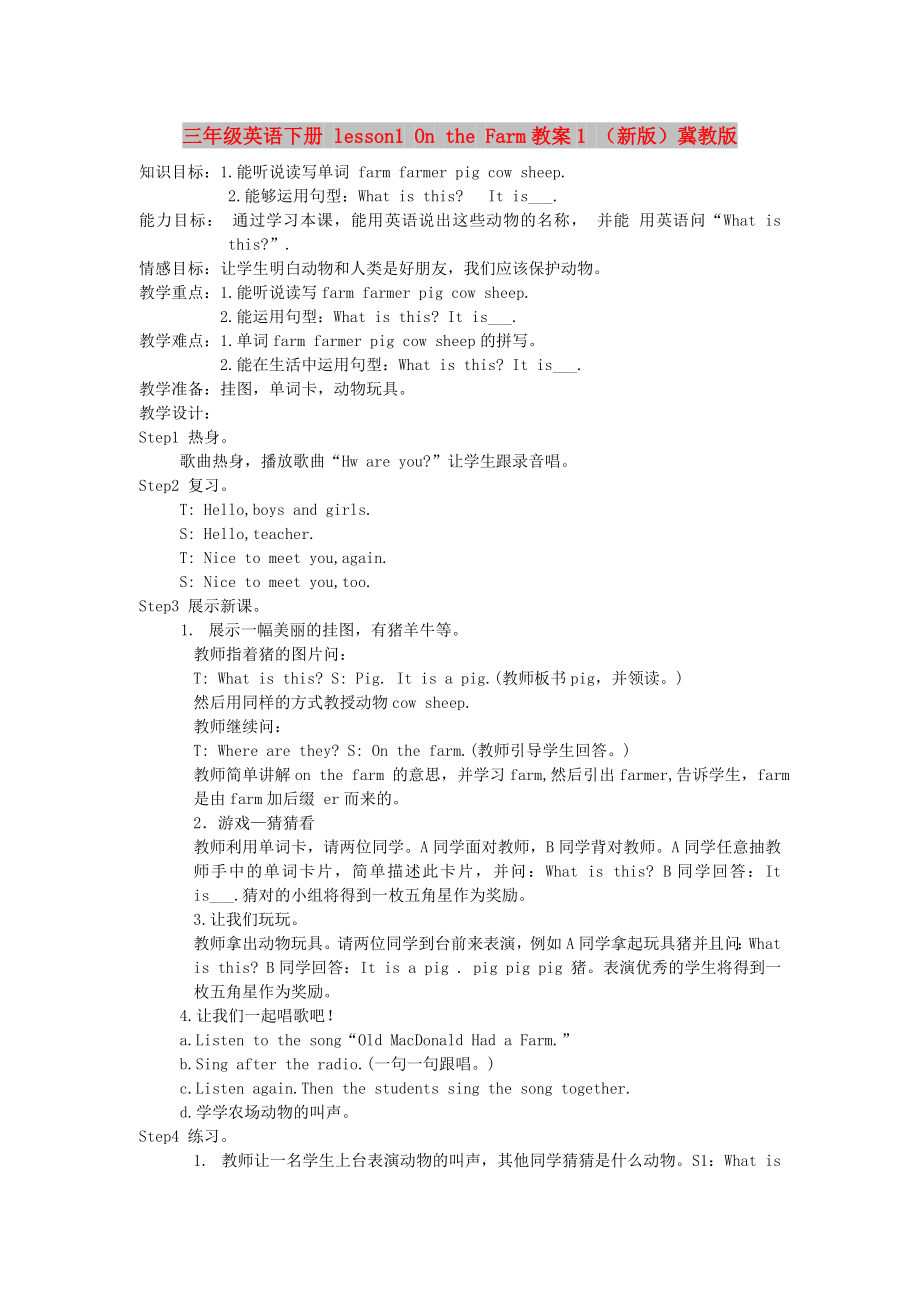《三年級(jí)英語(yǔ)下冊(cè) lesson1 On the Farm教案1 (新版)冀教版》由會(huì)員分享���,可在線閱讀����,更多相關(guān)《三年級(jí)英語(yǔ)下冊(cè) lesson1 On the Farm教案1 (新版)冀教版(3頁(yè)珍藏版)》請(qǐng)?jiān)谘b配圖網(wǎng)上搜索��。
1��、三年級(jí)英語(yǔ)下冊(cè) lesson1 On the Farm教案1 (新版)冀教版
知識(shí)目標(biāo):1.能聽(tīng)說(shuō)讀寫(xiě)單詞 farm farmer pig cow sheep.
2.能夠運(yùn)用句型:What is this? It is___.
能力目標(biāo): 通過(guò)學(xué)習(xí)本課����,能用英語(yǔ)說(shuō)出這些動(dòng)物的名稱, 并能 用英語(yǔ)問(wèn)“What is this?”.
情感目標(biāo):讓學(xué)生明白動(dòng)物和人類是好朋友���,我們應(yīng)該保護(hù)動(dòng)物�����。
教學(xué)重點(diǎn):1.能聽(tīng)說(shuō)讀寫(xiě)farm farmer pig cow sheep.
2.能運(yùn)用句型:What is this? It is___.
教學(xué)難
2�、點(diǎn):1.單詞farm farmer pig cow sheep的拼寫(xiě)。
2.能在生活中運(yùn)用句型:What is this? It is___.
教學(xué)準(zhǔn)備:掛圖�,單詞卡,動(dòng)物玩具�。
教學(xué)設(shè)計(jì):
Step1 熱身。
歌曲熱身�,播放歌曲“Hw are you?”讓學(xué)生跟錄音唱��。
Step2 復(fù)習(xí)����。
T: Hello,boys and girls.
S: Hello,teacher.
T: Nice to meet you,again.
S: Nice to meet you,too.
Step3 展示新課。
3��、
1. 展示一幅美麗的掛圖��,有豬羊牛等���。
教師指著豬的圖片問(wèn):
T: What is this? S: Pig. It is a pig.(教師板書(shū)pig����,并領(lǐng)讀。)
然后用同樣的方式教授動(dòng)物cow sheep.
教師繼續(xù)問(wèn):
T: Where are they? S: On the farm.(教師引導(dǎo)學(xué)生回答���。)
教師簡(jiǎn)單講解on the farm 的意思����,并學(xué)習(xí)farm,然后引出farmer,告訴學(xué)生���,farm是由farm加后綴 er而來(lái)的����。
2.游戲—猜猜看
教師利用單詞卡���,請(qǐng)兩位同學(xué)��。A同學(xué)面對(duì)教師����,B同學(xué)背對(duì)教師���。A同學(xué)任意抽教師手中的單詞卡片�����,簡(jiǎn)單描述此卡片���,并問(wèn)
4���、:What is this? B同學(xué)回答:It is___.猜對(duì)的小組將得到一枚五角星作為獎(jiǎng)勵(lì)。
3.讓我們玩玩�。
教師拿出動(dòng)物玩具。請(qǐng)兩位同學(xué)到臺(tái)前來(lái)表演��,例如A同學(xué)拿起玩具豬并且問(wèn):What is this? B同學(xué)回答:It is a pig . pig pig pig 豬�。表演優(yōu)秀的學(xué)生將得到一枚五角星作為獎(jiǎng)勵(lì)。
4.讓我們一起唱歌吧���!
a.Listen to the song“Old MacDonald Had a Farm.”
b.Sing after the radio.(一句一句跟唱。)
c.Listen again.Then the students sing t
5��、he song together.
d.學(xué)學(xué)農(nóng)場(chǎng)動(dòng)物的叫聲���。
Step4 練習(xí)����。
1. 教師讓一名學(xué)生上臺(tái)表演動(dòng)物的叫聲,其他同學(xué)猜猜是什么動(dòng)物���。S1:What is this? Ss: It is___.
2. 畫(huà)出你喜歡的動(dòng)物���,并標(biāo)出英語(yǔ),選出優(yōu)秀的圖片張貼到班級(jí)的墻上�����。
Step5結(jié)束課堂��。
Sing the song“Old MacDonald Had a Farm.” in groups.
Step6 家庭作業(yè)����。
1. 把今天所學(xué)的歌曲唱歌自己的爸爸媽媽聽(tīng)。
2. 把今天所學(xué)的單詞做成單詞卡��,課下用這些單詞卡和同學(xué)們做游戲����。
Step7 板書(shū)設(shè)計(jì)。
6��、 pig
What is this? It is a cow
Sheep
farm farmer
附送:
2019-2020年三年級(jí)英語(yǔ)下冊(cè) lesson1 On the Farm教案2 (新版)冀教版
一. 教學(xué)目標(biāo):
知識(shí)目標(biāo):1.能正確地聽(tīng)���、說(shuō)�����、讀�����、寫(xiě)農(nóng)場(chǎng)中的動(dòng)物單詞 farm ,farmer ,pig��,cow�����,sheep���,a.
2.能綜合運(yùn)用所學(xué)的語(yǔ)句進(jìn)行交際�。
— What’s this? —?? It’s a …
二. 能力目標(biāo):通過(guò)活動(dòng)培養(yǎng)學(xué)生能夠運(yùn)用
7�、所復(fù)習(xí)的詞匯和句子來(lái)正確表達(dá)周圍的具體實(shí)物�。
情感目標(biāo):促使學(xué)生積極運(yùn)用所學(xué)知識(shí)進(jìn)行表達(dá)與交流。
三.教學(xué)重���、難點(diǎn):能夠運(yùn)用所復(fù)習(xí)的詞匯來(lái)正確表達(dá)自己喜歡的動(dòng)物以及運(yùn)用所復(fù)習(xí)的句型進(jìn)行語(yǔ)言交際��。
四����、教具:錄音機(jī)和磁帶,課件��,教師用卡片和本課農(nóng)場(chǎng)的背景圖畫(huà)����,獎(jiǎng)勵(lì)用的小星和實(shí)物。
學(xué)具:學(xué)生用小卡片�。
五. 教學(xué)過(guò)程:
1.Greetings
T: Good afternoon, boys and girls.
S: Good afternoon, Miss Wang…
T: Let’s sing a song, Old MacDonald Hand a Farm. OK
8、?
S: OK!
(設(shè)計(jì)意圖: 營(yíng)造活躍輕松的課前氣氛���,使學(xué)生帶著積極的心態(tài)投入到學(xué)習(xí)中去���,英文歌曲也為下面的復(fù)習(xí)做鋪墊。)
2.Review the animals
Step1. Show the animals.
T: Do you want to visit Old MacDonald?
Now, let’s go to his farm.
(課件出示Old MacDonald圖片和農(nóng)場(chǎng)里的動(dòng)物們�。)
T: Look! Old McDonald is ing! Say hello to him.
Ss: Hello, MacDonald!
T: Look! Ther
9、e are a lot of animals on his farm,
what are these?
Step2. Ask and answer to review the animals.
T: What’s this?
Ss: It’s a sheep/cow/pig…
板書(shū):—What’s this?
—It’s a pig.
Ask the student to spell the important words.
Step3.Practice in pairs and present the dialogues.
What’s this? It’s a…
10�����、
Step4.Play games(課件展示游戲)
1.???? What’s missing?
2.???? Match the animals and the pictures.
Step5.Take out the text paper and finish number 1.
(設(shè)計(jì)意圖:這四個(gè)步驟�,通過(guò)課件給學(xué)生創(chuàng)設(shè)去農(nóng)場(chǎng)參觀的情境��,自然引入到本課的復(fù)習(xí)中��;通過(guò)學(xué)生認(rèn)讀��,師生對(duì)話���,同桌互練,做游戲和完成練習(xí)題一等活動(dòng)方式����,扎扎實(shí)實(shí)的進(jìn)行動(dòng)物單詞的聽(tīng)、說(shuō)���、讀��、寫(xiě)訓(xùn)練�,幫助學(xué)生鞏固已學(xué)知識(shí)�����。)
3.Review the sentences
六���、板書(shū):
Lesson 1 On the Farm
farm ,farmer ,pig�,cow����,sheep,
— What’s this? —?? It’s a …
 三年級(jí)英語(yǔ)下冊(cè) lesson1 On the Farm教案1 (新版)冀教版
三年級(jí)英語(yǔ)下冊(cè) lesson1 On the Farm教案1 (新版)冀教版

